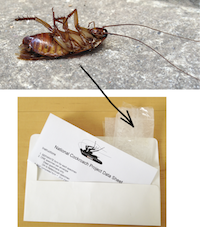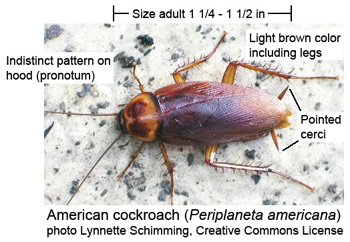National Cockroach Project
What
High school students and other citizen scientists collecting and helping analyze American cockroaches using DNA barcoding.
Status: Project completed. We thank our intrepid specimen collectors!
NCP in the News
Why
Genetic diversity is a window into evolution and patterns of migration. American cockroaches originated in Africa and hitchhiked around the world on commercial goods. This project asks:
- Do American cockroaches differ genetically between cities?
- Do US genetic types match those in other parts of the world?
- Are there genetic types that represent undiscovered look-alike species?
How

To participate, collect a cockroach!
What you need
- American cockroach (dead)
- Specimen label with collection location, date
- Mailing materials (click here for form with instructions)
What you get
- Thrill of scientific discovery with DNA
- Cool topic to talk about with friends
- DNA sequences you can analyze to study evolution
Background
- Number of P. americana DNA barcodes in public databases: 23 (2 from US)
- High school students found novel P. americana DNA barcode types in NYC (DNAHouse)
- P. americana on stage and screen: Featured in Broadway and Hollywood classic The Man Who Came to Dinner by Moss Hart and George S. Kaufman
FAQs
What is the American cockroach?

The American cockroach (Periplaneta americana), sometimes called palmetto bug or waterbug, is the commonest large roach in the U.S. (adults 1 ¼ – 1 ½ inches).
Periplaneta americana commonly inhabits warm, moist environments in man-made structures including basements of large buildings, steam tunnels, and sewers. It is a year-round indoor resident as far north as Canada.
The smaller cockroaches seen in homes and apartments are usually the German cockroach (Blattella germanica) (adults 1/2 – 5/8 inch).
In warm weather American cockroaches may be seen roaming urban sidewalks at night particularly near large buildings, street drains, and manhole covers.
What are other large (body size greater than or equal to 1 inch) cockroach species in the U.S.?
| Name | Distinguishing features vs. P. americana |
|---|---|
| Smokybrown cockroach (P. fuliginosa) | Uniformly dark brown color |
| Australian cockroachi (P. australasia) | Bright yellow along sides of head and body |
| Brown cockroach (P. brunnea) | Most similar to P. americana |
| Oriental cockroach (Blatta orientalis) | Uniformly dark color, short wings don’t cover abdomen |
The other Periplaneta species are found mostly in southeastern states; the Oriental cockroach is widely distributed.
More information on P. americana and its relatives including pictures is available on BugGuideNet and University of Florida Featured Creatures.
If you think your specimen is an American cockroach, mail it in!
How can you find a specimen?
Search around the basement of your school or apartment building, or ask for help from a building manager or a local exterminator. In warm weather keep your eyes open at night near large buildings, street drains, or manhole covers.
About the Bar Code of Life site
This web site is an outgrowth of
the Taxonomy, DNA, and Barcode of Life meeting held at Banbury
Center, Cold Spring Harbor Laboratory, September 9-12, 2003.
It is managed by Mark Stoeckle at the Program
for the Human Environment (PHE) at The Rockefeller University.
Contact: mark.stoeckle@rockefeller.edu
About the Program
for the Human Environment
The involvement of the Program for the Human Environment in DNA
barcoding dates to Jesse Ausubel's attendance in February 2002
at a conference in Nova Scotia organized by the Canadian Center
for Marine Biodiversity. At the conference, Paul Hebert
presented for the first time his concept of large-scale DNA
barcoding for species identification. Impressed by the
potential for this technology to address difficult challenges
in the Census of Marine Life, Jesse agreed with Paul on
encouraging a conference to explore the contribution
taxonomy and DNA could make to the Census as well as other large-scale
terrestrial efforts. In his capacity as a Program Director of
the Sloan Foundation, Jesse turned to the Banbury Conference
Center of Cold Spring Harbor Laboratory, whose leader Jan
Witkowski prepared a strong proposal to explore both the
scientific reliability of barcoding and the processes that
might bring it to broad application. Concurrently, PHE
researcher Mark Stoeckle began to work with the Hebert lab on
analytic studies of barcoding in birds. Our involvement in
barcoding now takes 3 forms: assisting the organizational
development of the Consortium for the Barcode of Life and the
Barcode of Life Initiative; contributing to the scientific
development of the field, especially by studies in birds, and
contributing to public understanding of the science and
technology of barcoding and its applications through improved
visualization techniques and preparation of brochures and other
broadly accessible means, including this website. While the
Sloan Foundation continues to support CBOL through a grant to
the Smithsonian Institution, it does not provide financial
support for barcoding research itself or support to the PHE for
its research in this field.
